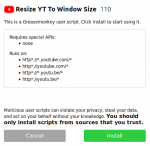Greasemonkey Manual:Installing Scripts: Difference between revisions
m Protected "Greasemonkey Manual:Installing Scripts": Excessive vandalism ([edit=sysop] (expires 16:13, 24 August 2010 (UTC)) [move=sysop] (expires 16:13, 24 August 2010 (UTC))) |
|||
| Line 1: | Line 1: | ||
{{Greasemonkey Manual TOC}} | {{Greasemonkey Manual TOC}} | ||
bejeweled_blitz_cheatbar.user.js | |||
== The Installation Dialog == | == The Installation Dialog == | ||
Revision as of 16:24, 14 September 2010
 Greasemonkey Manual |
| Using Greasemonkey |
|---|
| Installing Scripts |
| Monkey Menu |
| Getting Help |
| User Script Authoring |
| Editing |
| Environment |
| API |
bejeweled_blitz_cheatbar.user.js
The Installation Dialog
When navigating to a user script, Greasemonkey will open its installation dialog instead of loading the script like a normal page. A thumbnail of this dialog is shown to the left. It displays the name and description of the script, if available, as well as the include and exclude rules that apply.

- The Install button
This button will, of course, install the script in question. Like the Firefox extension installation dialog, this button is disabled for a few seconds to avoid the same potential security vulnerability.
- The Cancel button
This button will cancel the installation of a script.
- The View Script Source button
This button will allow viewing of the source code contained in the script. At this point, Greasemonkey has already downloaded the user script in question to display the name and other details.
When a user shows the script source, it displays the temporary file that Greasemonkey has already downloaded depicted in this screenshot. This is intentionally engineered to avoid a potential security problem. An evil server could deliver one innocent script for viewing, and on the second load an evil script for installing. This approach ensures that the script is downloaded only once. Upon examination of the visible script source, this copy is the script that will be installed.
Finally, in this window there is an information bar at the top similar to the Firefox extension installation security warning. This bar includes another Install button much like the the prior dialog. Clicking this button will also install the script. Using the Manage Dialog is the next step.